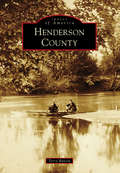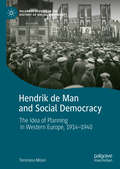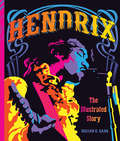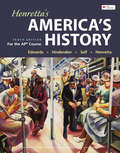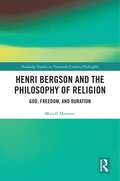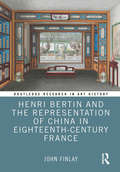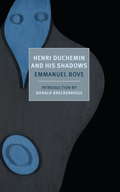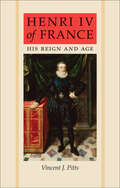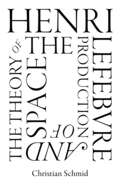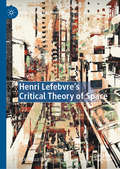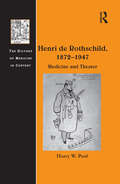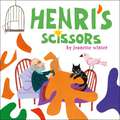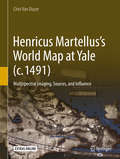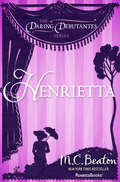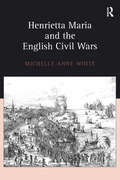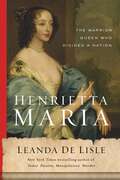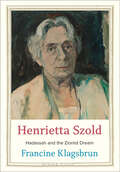- Table View
- List View
Henderson (Postcard History)
by Susan Sommers ThurmanThese vintage picture postcards take readers on a trip through the history of Henderson. Featured are the city's many remarkable parks, businesses, hotels, schools, and homes--some lost to time and some transported into the 21st century. The images and stories in this book will entertain and educate architecture buffs, rail fans, river enthusiasts, historians, and visitors and residents, past and present.
Henderson's Boys 3-Book Collection: Books 1-3 in the action-packed spy series
by Robert MuchamoreBooks 1, 2 and 3 in Robert Muchamore's Henderson's Boys series, the prequel to the bestselling CHERUB series The Escape (Book 1): The very first CHERUB adventure is about to begin ...Summer, 1940. Hitler's army is advancing towards Paris, and millions of French civilians are on the run. Amidst the chaos, two British children are being hunted by German agents. British spy Charles Henderson tries to reach them first, but he can only do it with the help of a twelve-year-old French orphan. The British secret service is about to discover that kids working undercover will help to win the war. Eagle Day (Book 2): Late summer, 1940. Hitler has conquered France. Now he intends to cross the Channel and defeat Britain before winter arrives. A group of young refugees led by British spy Charles Henderson faces a stark choice. To head south into the safety of neutral Spain or go north on a risky mission to sabotage the German invasion plans. Secret Army (Book 3): Britain, 1941. The government is building a secret army of intelligence agents to work undercover, gathering information and planning sabotage operations. Henderson's boys are part of that network: kids cut adrift by the war, training for the fight of their lives. They'll have to parachute into unknown territory, travel cross-country and outsmart a bunch of adults in a daredevil exercise. In wartime Britain, anything goes. Praise for the CHERUB series: 'Punchy, exciting, glamorous and, what's more, you'll completely wish it was true' - Sunday Express 'Crackling tension and high-octane drama' - Daily Mail 'A really good book that you could re-read over and over again' - Guardian 'Pacy writing, punchy dialogue and a gripping plot, it's got it all' - Daily Express 'Fast-moving action ... and cool gadgets!' - The Times Visit cherubcampus.com - the essential internet destination, packed with exclusive content and with in-depth biographies of CHERUB characters, out-takes and bonus stories.
Henderson's Boys 3-Book Collection: Books 1-3 in the action-packed spy series (Henderson's Boys #1007)
by Robert MuchamoreBooks 1, 2 and 3 in Robert Muchamore's Henderson's Boys series, the prequel to the bestselling CHERUB series The Escape (Book 1): The very first CHERUB adventure is about to begin ...Summer, 1940. Hitler's army is advancing towards Paris, and millions of French civilians are on the run. Amidst the chaos, two British children are being hunted by German agents. British spy Charles Henderson tries to reach them first, but he can only do it with the help of a twelve-year-old French orphan. The British secret service is about to discover that kids working undercover will help to win the war. Eagle Day (Book 2): Late summer, 1940. Hitler has conquered France. Now he intends to cross the Channel and defeat Britain before winter arrives. A group of young refugees led by British spy Charles Henderson faces a stark choice. To head south into the safety of neutral Spain or go north on a risky mission to sabotage the German invasion plans. Secret Army (Book 3): Britain, 1941. The government is building a secret army of intelligence agents to work undercover, gathering information and planning sabotage operations. Henderson's boys are part of that network: kids cut adrift by the war, training for the fight of their lives. They'll have to parachute into unknown territory, travel cross-country and outsmart a bunch of adults in a daredevil exercise. In wartime Britain, anything goes. Praise for the CHERUB series: 'Punchy, exciting, glamorous and, what's more, you'll completely wish it was true' - Sunday Express 'Crackling tension and high-octane drama' - Daily Mail 'A really good book that you could re-read over and over again' - Guardian 'Pacy writing, punchy dialogue and a gripping plot, it's got it all' - Daily Express 'Fast-moving action ... and cool gadgets!' - The Times Visit cherubcampus.com - the essential internet destination, packed with exclusive content and with in-depth biographies of CHERUB characters, out-takes and bonus stories.
Hendrik de Man and Social Democracy: The Idea of Planning in Western Europe, 1914–1940 (Palgrave Studies in the History of Social Movements)
by Tommaso MilaniThe book investigates the intellectual and political trajectory of the Belgian theorist Hendrik de Man (1885-1953) by examining the impact that his works and activism had on Western European social democracy between the two world wars. Based on multinational archival research, the book highlights how the idea of economic planning became part of a wider effort to address an ideological crisis within the socialist movement and revitalise the latter amidst the Great Depression. A heavily controversial figure also because of his subsequent involvement in Belgian wartime collaboration, de Man played a pivotal role in challenging traditional Marxist assumptions about the role of the state under capitalism and in promoting transnational exchanges between unorthodox social democrats across Europe. Starting from de Man’s experience in World War I, the book analyses his departure from Marxism, his elaboration of an alternative social democratic paradigm, his entry in Belgian politics as well as the reception of his thought in France and Britain.
Hendrix: The Illustrated Story
by Gillian G. GaarThis definitive, illustrated biography explores the life and career of the rock music legend with photographs, posters, and other ephemera.Every music critic to rank the Greatest Rock Guitarists of All Time agrees on one thing: Jimi Hendrix is number one. Hendrix enjoyed the international limelight for less than four years, but his innovative guitar playing and imaginative interpretations of blues and rock continue to inspire generations of musicians and music lovers.In Hendrix, music journalist Gillian Gaar explores the guitarist's life from his childhood in Seattle to his service as an Army paratrooper, his role as a sideman on the chitlin' circuit, his exile in the United Kingdom, his rise to superstardom, and his untimely death in 1970. The volume is enhanced throughout with rare archival photographs as well as posters, picture sleeves, and other assorted memorabilia.
Hengeworld
by Michael PittsIn November 1997 English Heritage announced the discovery of a vast prehistoric temple in Somerset. The extraordinary wooden rings at Stanton Drew are the most recent and biggest of a series of remarkable discoveries that have transformed the way archaeologists think of the great monuments in the region, including Avebury and Stonehenge; one of the world's most famous prehistoric monuments, top tourist site and top location for summer solstice celebrations. The results of these discoveries have not been published outside academic journals and no one has considered the wider implications of these finds. Here Mike Pitts, who has worked as an archaeologist at Avebury, and has access to the unpublished English Heritage files, asks what sort of people designed and built these extraordinary neolithic structures - the biggest in Britain until the arrival of medieval cathedrals. Using computer reconstructions he shows what they looked like and asks what they are for. This is the story of the discovery of a lost civilisation that spanned five centuries, a civilisation that now lies mostly beneath the fields of Southern England.
Henna House: A Novel
by Nomi Eve&“A touching coming-of-age story&” (Publishers Weekly) in the tradition of Anita Diamant&’s The Red Tent, about a young woman, her family, their community and the customs that bind them, from &“a storyteller of uncommon energy and poise&” (Michiko Kakutani, The New York Times).This vivid saga begins in Yemen in 1920. Adela Damari’s parents’ health is failing as they desperately seek a future husband for their young daughter, who is in danger of becoming adopted by the local Muslim community if she is orphaned. With no likely marriage prospects, Adela’s situation looks dire—until she meets two cousins from faraway cities: a boy with whom she shares her most treasured secret, and a girl who introduces her to the powerful rituals of henna. Ultimately, Adela’s life journey brings her old and new loves, her true calling, and a new life as she is transported to Israel as part of Operation On Wings of Eagles. Rich, evocative, and enthralling, Henna House is an intimate family portrait interwoven with the traditions of the Yemenite Jews and the history of the Holocaust and Israel. This sensuous tale of love, loss, betrayal, forgiveness—and the dyes that adorn the skin and pierce the heart—will captivate readers until the very last page.
Henretta's America's History for the AP® Course
by James A. Henretta Rebecca Edwards Robert O. Self Eric HinderakerHenretta�s America�s History helps students succeed in the updated AP� U.S. History course with a thematic approach, skills-oriented pedagogy, and a multitude of AP�-style practice questions.
Henri Bergson and the Philosophy of Religion: God, Freedom, and Duration (Routledge Studies in Twentieth-Century Philosophy)
by Matyáš MoravecThis book connects the philosophy of Henri Bergson to contemporary debates in metaphysics and analytic philosophy of religion. More specifically, the book demonstrates how Bergson’s philosophy of time can respond to the problem of foreknowledge and free will. The question of how humans can be free if God knows everything has been a perennial issue of debate in analytic philosophy of religion. The solution to this problem relies heavily on what one thinks about time. The problem of time is central to Bergson’s philosophical system. In this book, the author offers a systematic application of Bergson’s thought to the freedom and foreknowledge problem. The first chapter presents a discussion of Bergson’s central concept of la durée (duration). The subsequent two chapters link la durée to the relation of time and space. Here the author provides a Bergsonian response to McTaggart’s argument for the unreality of time and develops a novel theory of time connected to Bergson’s analysis of temporal experience. The last three chapters explore the relation between free will, determinism, and divine foreknowledge. The author reconstructs Bergson’s theory of freedom and shows how it undermines the underlying dogmas of contemporary free-will theories. The author then argues that Bergson’s philosophy can be used to resolve the free will and foreknowledge problem in the philosophy of religion. The monograph concludes by opening avenues for new research into Bergson and analytic philosophy of religion, such as the philosophy of religious language, the relation between God and modality, religious experience, and religious pluralism. Henri Bergson and the Philosophy of Religion will be of interest to scholars and advanced students working on Bergson, 20th-century continental philosophy, philosophy of religion, and philosophy of time.
Henri Bergson: The Philosophy of Change
by Herbert Wildon CarrImmerse yourself in the revolutionary ideas of one of the most influential philosophers of the early 20th century with Herbert Wildon Carr's Henri Bergson: The Philosophy of Change. This illuminating work offers a comprehensive and accessible introduction to the thought of Henri Bergson, whose concepts of time, consciousness, and creativity have profoundly impacted modern philosophy.Herbert Wildon Carr, a respected philosopher and Bergson scholar, provides a detailed and insightful exploration of Bergson's philosophy. Henri Bergson: The Philosophy of Change delves into the core ideas that define Bergson's work, such as his distinction between clock time and lived time (durée), the nature of creative evolution, and the concept of élan vital (vital impulse).Carr expertly unpacks Bergson's complex theories, making them accessible to readers new to his work while offering deep insights for those already familiar with his philosophy. The book explores how Bergson's ideas challenge traditional mechanistic views of the universe, proposing instead a dynamic and fluid understanding of reality.Henri Bergson: The Philosophy of Change also examines Bergson's influence on a wide range of disciplines, from psychology and biology to literature and the arts. Carr discusses how Bergson's ideas have inspired and intersected with the work of other prominent thinkers and how his philosophy continues to resonate in contemporary debates about consciousness and the nature of time.Join Herbert Wildon Carr on a journey through the innovative and transformative philosophy of Henri Bergson, and discover how his ideas on change and creativity continue to inspire and challenge our perceptions of reality. Henri Bergson: The Philosophy of Change is a timeless exploration of one of philosophy's most dynamic thinkers.
Henri Bertin and the Representation of China in Eighteenth-Century France (Routledge Research in Art History)
by John FinlayThis is an in-depth study of the intellectual, technical, and artistic encounters between Europe and China in the late eighteenth century, focusing on the purposeful acquisition of information and images that characterized a direct engagement with the idea of "China." The central figure in this story is Henri-Léonard Bertin (1720–1792), who served as a minister of state under Louis XV and, briefly, Louis XVI. Both his official position and personal passion for all things Chinese placed him at the center of intersecting networks of like-minded individuals who shared his ideal vision of China as a nation from which France had much to learn. John Finlay examines a fascinating episode in the rich history of cross-cultural exchange between China and Europe in the early modern period, and this book will be an important and timely contribution to a very current discussion about Sino-French cultural relations. This book will be of interest to scholars in art history, visual culture, European and Chinese history.
Henri Duchemin and His Shadows
by Alyson Waters Emmanuel Bove Donald BreckenridgeAn NYRB Classics OriginalEmmanuel Bove was one of the most original writers to come out of twentieth-century France and a popular success in his day. Discovered by Colette, who arranged for the publication of his first novel, My Friends, Bove enjoyed a busy literary career, until the German occupation silenced him. During his lifetime, his novels and stories were admired by Rilke, the surrealists, Camus, and Beckett, who said of him that "more than anyone else he has an instinct for the essential detail." Henry Duchemin and His Shadows is the ideal introduction to Bove's world, with its cast of stubborn isolatoes who call to mind Melville's Bartleby, Walser's "little men," and Rhys's lost women. Henri Duchemin, the protagonist of the collection's first story, "Night Crime," is ambivalent, afraid of appearing ridiculous, desperate for money: in other words, the perfect prey. Criminals, beautiful women, and profiteers threaten the sad young men of Bove's stories, but worse yet are the interior voices and paranoia that propel them to their fates. The poet of the flophouse and the dive, the park bench and the pigeon's crumb, Bove is also a deeply empathetic writer for whom no defeat is so great as to silence desire.
Henri Fayol, the Manager (Studies in Business History #6)
by Jean-Louis Peaucelle Cameron GuthrieHenri Fayol is one of the most important management theorists of the twentieth century. Guthrie and Peaucelle present a study of Fayol's management, comparing the theories set out in his book with his hands-on experience and practice. The first English translation of the third part of Industrial and General Management appears as an Appendix.
Henri IV of France: His Reign and Age
by Vincent J. PittsVincent J. Pitts chronicles the life and times of one of France’s most remarkable kings in the first English-language biography of Henri IV to be published in twenty-five years. An unwelcome heir to the throne, Henri ruled over a kingdom plagued by religious civil war and political and economic instability. By the end of his reign in 1610 he had pacified his warring country, restored its prosperity, and reclaimed France’s place as a leading power in Europe. Pitts draws upon the rich scholarship of recent decades to tell the captivating story of this pivotal French king. From boyhood, Henri was destined to be leader and protector of the Huguenot movement in France. He served as chief of the Calvinist party and fought for the Huguenot forces in the bloody Wars of Religion before an extraordinary sequence of dynastic mishaps left the Protestant warlord next in line for the French crown. Henri was forced to renounce his faith in support of his claim to the Catholic throne and to unite his deeply divided country. A master of political maneuvering, Henri restored order to a country in the throes of great religious, political, and economic upheaval. He was assassinated in 1610 by a Catholic zealot.Vincent Pitts expertly recounts this history and skillfully untangles its complex set of personalities and events. Pitts engages the vast amount of literature relating to the king himself as well as the large body of recent scholarship on France during this time. The result is a fascinating biography of a French king and a comprehensive history of sixteenth-century France.
Henri Lefebvre and the Theory of the Production of Space
by Christian SchmidHenri Lefebvre&’s was the major theorist of space and of the urban. This is the definitive book on Lefebvre.This book presents an encompassing, detailed and thorough overview and reconstruction of Lefebvre&’s theory of space and of the urban.Henri Lefebvre belongs to the generation of the great French intellectuals and philosophers, together with his contemporaries Michel Foucault and Jean-Paul Sartre. His theory has experienced a remarkable revival over the last two decades, and is discussed and applied today in many disciplines in humanities and social sciences, particularly in urban studies, geography, urban sociology, urban anthropology, architecture and planning. Lefebvre, together with David Harvey, is one of the leading and most read theoreticians in these fields.This book explains in an accessible way the theoretical and epistemological context of this work in French philosophy and in the German dialectic (Hegel, Marx, and Nietzsche), and reconstructs in detail the historical development of its different elements. It also gives an overview on the receptions of Lefebvre and discusses a wide range of applications of this theory in many research fields, such as urban and regional development, urbanization, urbanity, social space, and everyday life.
Henri Lefebvre's Critical Theory of Space (Marx, Engels, and Marxisms)
by Francesco BiagiHenri Lefebvre's Critical Theory of Space offers a rigorous analysis and revival of Lefebvre’s works and the context in which he produced them. Biagi traces the historical-critical time-frame of Lefebvre's intellectual investigations, bringing to light a theoretical constellation in which historical methods intersect with philosophical and sociological issues: from Marxist political philosophy to the birth of urban sociology; from rural studies to urban and everyday life studies in the context of capitalism. Examining Lefebvre’s extended investigations into the urban sphere as well as highlighting his goal of developing a “general political theory of space” and of innovating Marxist thought, and clarifying the various (more or less accurate) meanings attributed to Lefebvre's concept of the “right to the city” (analysed in the context of the French and international sociological and philosophical-political debate), Henri Lefebvre's Critical Theory of Space ultimately brings the contours of Lefebvre’s innovative perspective—itself developed at the end of the “short twentieth century”—back into view in all its richness and complexity.
Henri de Rothschild, 1872–1947: Medicine and Theater (The History of Medicine in Context)
by Harry W. PaulDr Henri de Rothschild was a fifth generation Rothschild and perhaps the most famous of the Paris Rothschilds of the fin-de-siècle period. A 'sleeping partner' of the bank and the non-drinking owner of Mouton-Rothschild, Henri spent much of his life building medical institutions and promoting scientific medicine, including the promotion of Ehrlich's Salvarsan to cure syphilis and the use of radium to cure cancer. His hospital in a working class area of northern Paris boasted the latest in medical advances. Henri was particularly influential in developing the new science of infant feeding, while his broader concerns with infant health led to his playing a prominent role in the development of the specialty of pediatrics. This biography of Henri de Rothschild focuses on his medical achievements and that of his close family in France. Henri, his wife Mathilde and his mother Thérèse all had busy medical careers during World War I. The book also gives an account of both women's experiences of the war. Along with his explicitly scientific medical concerns, Henri was also a prolific playwright and, under the pseudonym André Pascal, wrote several plays about doctors. This book situates the plays, and particularly the themes of charlatanism, women doctors and medical ethics, in their contemporary context of the social and medical life of Paris. A fascinating and vividly written study of a somewhat neglected figure in the history of the illustrious Rothschild family, this book will make a valuable addition to the libraries of scholars in the history of medicine and those studying child health and welfare, the portrayal of doctors in literature, and more broadly the social and cultural life of early-twentieth century Paris.
Henri's Scissors
by Jeanette WinterStep into the colorful world of Henri Matisse and his magnificent paper cutouts in this biography by acclaimed picture book creator Jeanette Winter. <p><p> In a small weaving town in France, a young boy named Henri-Emile Matisse drew pictures everywhere, and when he grew up, he moved to Paris and became a famous artist who created paintings that were adored around the world. But late in life a serious illness confined him to a wheelchair, and amazingly, it was from there that he created among his most beloved works—enormous and breathtaking paper cutouts. <p><p> Based on the life of Henri Matisse, this moving and inspirational picture book biography includes a note from the author, dynamic quotes from Matisse himself, and an illuminating look at a little-known part of a great artist’s creative process.
Henricus Martellus’s World Map at Yale: Multispectral Imaging, Sources, and Influence (c. #1491)
by Chet Van DuzerThis book presents groundbreaking new research on a fifteenth-century world map by Henricus Martellus, c. 1491, now at Yale. The importance of the map had long been suspected, but it was essentially unstudiable because the texts on it had faded to illegibility. Multispectral imaging of the map, performed with NEH support in 2014, rendered its texts legible for the first time, leading to renewed study of the map by the author. This volume provides transcriptions, translations, and commentary on the Latin texts on the map, particularly their sources, as well as the place names in several regions. This leads to a demonstration of a very close relationship between the Martellus map and Martin Waldseemüller’s famous map of 1507. One of the most exciting discoveries on the map is in the hinterlands of southern Africa. The information there comes from African sources; the map is thus a unique and supremely important document regarding African cartography in the fifteenth century. This book is essential reading for digital humanitarians and historians of cartography.
Henrietta (The Daring Debutantes Series #2)
by M. C. BeatonA spirited spinster takes aim at a prized bachelor in this Edwardian romance by the New York Times–bestselling author of the Agatha Raisin mysteries.Even the inhabitants of secluded Nethercote look pityingly upon young Henrietta, the Vicar&’s sister; her plain features seem to almost guarantee her a solitary future. And yet, she has a determined spirit and magnificent hazel eyes. So when her Great-Aunt Hester leaves her unexpected wealth, Henrietta sets out to conquer London&’s glittering high society and confound them all. But the fashionable elite are less than warm in their reception, especially when the newcomer, this bold minx, makes clear her intention of winning the heart of one of society&’s most treasured gems: the irresistible, extravagant, heart-stopping Lord Beau Reckford, a prize wildly beyond her humble origins…ABOUT THE COLLECTION The seven heroines of the Daring Debutantes Collection set out to conquer London&’s glittering high society and the marriage mart. These headstrong women cannot help but keep London society dangling on a string, but will they find a husband or lose themselves in the game?
Henrietta Maria and the English Civil Wars
by Michelle WhiteThe influence exercised by Queen Henrietta Maria over her husband Charles I during the English Civil Wars, has long been a subject of interest. To many of her contemporaries, especially those sympathetic to Parliament, her French origins and Catholic beliefs meant that she was regarded with great suspicion. Later historians picking up on this, have spent much time arguing over her political role and the degree to which she could influence the decisions of her husband. What has not been so thoroughly investigated, however, are issues surrounding the popular perceptions of the Queen that inspired the plethora of pamphlets, newsbooks and broadsides. Although most of these documents are polemical propaganda devices that tell us little about the actual power wielded by Henrietta Maria, they do throw much light on how contemporaries viewed the King and Queen, and their relationship. The picture created by Charles and Henrietta's enemies was one of a royal household in patriarchal disorder. The Queen was characterized as an overly assertive, unduly influential, foreign, Catholic queen consort, whilst Charles was portrayed as a submissive and weak husband. Such an image had wide political ramifications, resulting in accusations that Charles was unfit to rule, and thus helping to justify Parliamentary resistance to the monarch. Because Charles had permitted his Catholic wife to interfere in state matters he stood accused of threatening the patriarchal order upon which all of society rested, and of imperilling the Church of England. In this book Michelle White tackles these dual issues of Henrietta's actual and perceived influence, and how this was portrayed in popular print by those sympathetic and hostile to her cause. In so doing she presents a vivid portrait of a strong willed woman who had a profound influence on the course of English history.
Henrietta Maria: Piety, Politics and Patronage (Women and Gender in the Early Modern World)
by Erin GriffeyCompiled by art historians, literary scholars, musicologists, and historians, this essay collection is an innovative and interdisciplinary study of Queen Henrietta Maria and her multi-faceted roles and responsibilities. Elements of the queen's popular biography - her European identity and devout Catholic faith - are only a part of the backdrop against which Henrietta Maria is re-considered. Drawing on the expertise of an international group of scholars from different disciplines, these essays explore and shed new light on the Queen's various roles: a patron of performing and visual arts with taste and influence comparable to her husband's, her salient political position between the French and English courts, and her political sentiments at the outbreak of the English Civil War. Through cutting-edge archival research that includes investigations into household accounts and personal correspondence, this collection ultimately presents a new assessment of female power and influence at the early modern court. What becomes strikingly evident is that Henrietta Maria had a distinct and profound influence on material and political culture that deserves the attention of art history, literature, theatre, and musicology scholars.
Henrietta Maria: The Warrior Queen Who Divided a Nation
by Leanda de LisleDispelling the myths around this legendary queen, this biography of Henrietta Maria, queen consort of King Charles I, retells the dramatic story of the English Civil War from the perspective of this dynamic woman.Henrietta Maria is British history&’s most reviled queen consort. Condemned in her lifetime as the "Popish brat of France,&” an adulteress, and a traitor, she remains in popular memory the wife who wore the breeches in her marriage, the woman who turned her husband Catholic (and so caused the English Civil War), and a cruel and bigoted mother. This clear-eyed biography unpicks the myths and considers the story from Henrietta Maria's point of view. A portrait emerges of a woman whose closest friends included Puritans as well as Catholics, who crossed swords with Cardinal Richelieu, and led the anti-Spanish faction at the English court. A witty conversationalist, Henrietta Maria was a patron of the arts and a champion of the female voice, as well as a mediatrix for her persecuted fellow Catholics. During the civil war, the queen's enemies agreed that Charles would never have survived as long as he did without the "She Generalissimo." Seeing events through her gaze reveals the truth behind the claims that she caused the war, explains her estrangement from her son Henry, and diminishes the image of the Restoration queen as an irrelevant crone. In fact, Henrietta Maria rose from the ashes of her husband's failures—a "phoenix queen&”—presiding over a court judged to have had "more mirth&” even than that of the Merry Monarch, Charles II. It is time to look again at this often-criticized queen and determine if she is not, in fact, one of British history's most remarkable women.
Henrietta Szold: Hadassah and the Zionist Dream (Jewish Lives)
by Francine KlagsbrunAward-winning author Francine Klagsbrun reveals the complex life and work of Henrietta Szold, founder of Hadassah and a Zionist trailblazer Henrietta Szold (1860–1945) is renowned as the founder of Hadassah, the Women&’s Zionist Organization of America, which quickly became one of the most successful of all Zionist groups. In her work with Hadassah, Szold used a combined ethical and pragmatic approach aimed at improving the lives of both Jews and Arabs. She later moved to Mandate Palestine to help shape education, health, and social services there. The pinnacle of her career came in her seventies, when she took on the task of directing the Youth Aliyah program, which rescued thousands of young people from the Nazis and resettled them in Palestine. Using Szold&’s copious letters, diaries, and essays, along with other archival documents, Francine Klagsbrun traces Szold&’s life and legacy with an eye to uncovering the person behind the Zionist icon. She reveals Szold as a complex human being who had to cope with controversy and criticism, a workaholic with an outsized sense of duty, and an idealist who fought for her beliefs even as she questioned her own abilities. With deep insight, Klagsbrun introduces readers to this extraordinary woman, whose impact on women&’s lives as well as on education and health systems still resonates.

